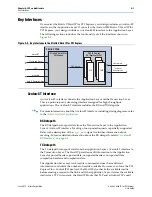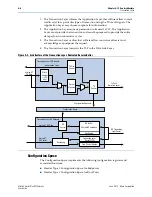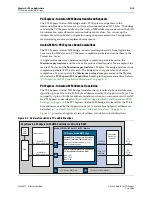
5–4
Chapter 5: IP Core Architecture
Key Interfaces
Stratix V Hard IP for PCI Express
June 2012
Altera Corporation
credits become available. By tracking the credit consumed information and
calculating the credits available, the Application Layer can optimize performance by
selecting for transmission only the TLPs that have credits available. Refer to
for more information about the signals in this interface.
Avalon-MM Interface
In Qsys, the Stratix V Hard IP for PCI Express is available with either an Avalon-ST
interface or an Avalon-MM interface to the Application Layer. When you select the
Avalon-MM Stratix V Hard IP for PCI Express, an Avalon-MM bridge module
connects the PCI Express link to the system interconnect fabric. If you are not familiar
with the PCI Express protocol, variants using the Avalon-MM interface may be easier
to understand. A PCI Express to Avalon-MM bridge translates the PCI Express read,
write and completion TLPs into standard Avalon-MM read and write commands
typically used by master and slave interfaces. The PCI Express to Avalon-MM bridge
also translates Avalon-MM read, write and read data commands to PCI Express read,
write and completion TLPs.
Clocks and Reset
The
PCI Express Base Specification
requires an input reference clock, which is called
refclk
in this design. Although the
PCI Express Base Specification
stipulates that the
frequency of this clock be 100 MHz, the Hard IP also accepts a 125 MHz reference
clock as a convenience. You can specify the frequency of your input reference clock
using the parameter editor under the
System Settings
heading.
The
PCI Express Base Specification
also requires a system configuration time of 100 ms.
To meet this specification, the Stratix V Hard IP for PCI Express includes a hard reset
controller. This reset controller exits the reset state after the I/O ring of the device is
initialized. For more information about clocks and reset, refer to
, and
“Reset Signals and Status Signals” on
Local Management Interface (LMI Interface)
The LMI bus provides access to the PCI Express Configuration Space in the
Transaction Layer. For more LMI details, refer to
Hard IP Reconfiguration
The PCI Express reconfiguration bus allows you to dynamically change the
read-only
values stored in the Configuration Registers. For detailed information, refer to
IP Reconfiguration Interface” on page 6–44
.
Transceiver Reconfiguration
The transceiver reconfiguration interface allows you to dynamically reconfigure the
values of analog settings in the PMA block of the transceiver. Dynamic
reconfiguration is necessary to compensate for process variations at the 28 nm process
technology. The Altera Transceiver Reconfiguration Controller IP core provides access
to these analog settings. For more information about the transceiver reconfiguration
signals, refer to
“Physical Layer Interface Signals” on page 6–52
.
















































